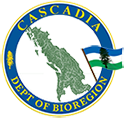Cascadia — the evocative name of a region, an idea, a movement — wild and free, defined by the waters flowing from the continental crest through the headwaters of the Pacific.
Cascadia is a bioregion, the place we call home, an identity, movement and positive vision for the future.
But what and where exactly did the name Cascadia arise from?
Surrounding the three main cities of Cascadia, many people assume that Cascadia is named after the Cascade Mountain Range of Western British Columbia, Oregon and Washington. With rugged volcanoes standing thousands of meters high, surely one can feel it on the slopes of the Cascade Mountains, streaming white ribbons all around…. but these guess in truth, are actually a bit off the mark. While the Cascade Mountains are certainly centrally located, both in geographic location and central to our imagination and identity of many Cascadians, it’s by no means the defining feature or border of Cascadia – not to the Redwoods in California, and certainly not to the Mt St Alias range in Alaska, nor is it where we garner the name.
Instead, Cascadia is defined by – you guessed it, the cascading waters – from it’s most eastern edges of the continental divide and Yellowstone calders – as is cascades and flows to it’s final terminus in the Pacific slope. So rather than the name Cascadia come from the Cascade mountains – it is actually the other way around – that the Cascades take their name from the same source. This term “Cascades” was first used for the Cascade Rapids, as early as the Astor Expedition but the first written reference originally stems from Scottish botanist David Douglas (for whom the Douglas Fir is also named) who explored the Columbia River Gorge in 1825.
He wrote of the area’s ‘cascading waterfalls’, and it is through these that we hear the first mention of ‘the Cascades’ — from which the mountain range is now called.
The name ‘Cascadia’ itself wasn’t heard until much later, until it was first used by the town Cascadia, Oregon that was settled in 1890 in what is now Linn County. In a more recent context — “Cascadia” was first applied to the whole geologic region by Bates McKee in his 1972 geology textbook Cascadia; the geologic evolution of the Pacific Northwest. Later the name was adopted by David McCloskey, a Seattle University sociology professor, to describe it as a bioregion. McCloskey describes Cascadia as “a land of falling waters.”
As denoted by David McCloskey “ This movement is a spontaneous emergence arising from the people of the place, a true ecocultural development. It is gratifying to see so many people calling themselves Cascadian and speaking of things Cascadian. According to McCloskey, this “initial” Cascadia included parts of seven jurisdictions (Northern California, Oregon, Washington, Idaho, Western Montana, British Columbia, and Southeast Alaska), running from the northernmost reaches of Southeast Alaska in the north to Cape Mendocino, California in the south–and covering all the land and “falling waters” from the continental divide at the Rocky Mountains to the Pacific Ocean. McCloskey, founder of the Cascadia Institute and co‐chair of Seattle University’s New Ecological Studies Program, saw Cascadian identity as something which transcends political or geographic definitions; it is more a cultural, ideological identity.
He notes the blending of the natural integrity and the sociocultural unity that gives Cascadia its definition.This new notion of Cascadia, was heavily influenced by the bioregionalism movement of the 1970’s, inspired by Peter Berg and the Drum Foundation., seminal works like Joel Garraeu’s Nine Nations of North America, and Ernest Callenbachs novel Ecotopia, which portrayed an independent eco-state of the Northwest.
Cascadia is used to define a unique regional character found within the Pacific Northwest, and extends to a wide range of beers (Cascadia Dark Ale), sports (the Cascadia Cup) and music (Cascadian Black Metal) just to name a few. Hundreds of businesses, individuals, organizations, and causes now all use the term. The idea has since been adopted by a wide range of researchers who highlight the growing importance of regional growth management, environmental planning, economic cooperation, as well as disaster preparedness. Support for the idea also comes from institutions and businesses such as the Bullit Foundations ‘Cascadia Center’, the adoption of the Cascadia Megaregion by federal policy makers, and the tectonic Cascadia Subduction Zone.



Post a comment